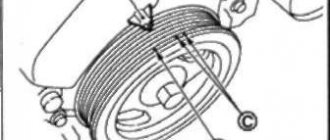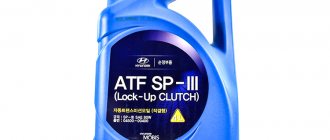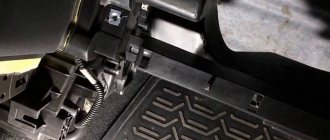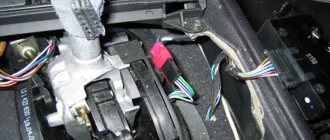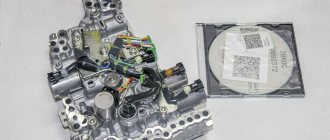How often should the variator be serviced?
Nissan CVT
According to the regulations, the lubricant in the Nissan variator must be changed after 60 thousand kilometers. So keep an eye on the meter. In addition, the following characteristic signs may indicate the need for replacement:
- Jerking when starting to move due to the accumulation of metal shavings on the pressure reducing valve.
- Jamming causes mismatched operation of cone-shaped pulleys.
- Increasing the operating temperature of the lubricant inside the continuously variable transmission.
- Extraneous noise while driving.
- Old oil and accumulated wear products contribute to bearing noise.
CVT design
The operating conditions of a continuously variable transmission (road surface characteristics, time of year, driving style) determine its service life - up and down.
In practice, it is recommended to change the CVT fluid every 30-40 thousand km.
In parallel with changing the oil, it is necessary to install a new fine filter and clean the pan. During the first maintenance, the coarse filter is simply washed and replaced. On used cars, it becomes necessary to clean the chip-catching magnets.
Replacing the variator oil fine filter
vasvi
Moderator
Greetings!
As you know, our variator oil fine filter is supposedly maintenance-free. The service procedures do not contain any recommendations for replacing it. We all know what such “extended” lack of maintenance leads to. Filter catalog number: 31726-3XX0A Catalog number of the filter flask sealing ring: 31526-3VX0A (for 2.0 and 1.6). For 1.2 - 31526-3JX1B I decided to take a look and see the condition of the filter on my car with a mileage of 16t.km. The mileage is quite low, so I was hoping to see a fairly clean filter. Access to the filter is very good from below. To remove the filter you need a 10 mm spanner:
We wipe clean all the dust and dirt under the flask to collect the drained oil in a clean container. When unscrewing, about 90-100 ml of oil is drained. The condition of the filter turned out to be not at all great: And this is only for 16t.km. With my fairly calm driving, I rarely fire it up. The filter is not just black, there is a decent layer of friction products on its surface.
Filter size: length 63 mm, diameter 37 mm. Most likely, in addition to the above catalog number, 31726-3JX0A is also suitable, which has exactly the same dimensions and shape (photos are in Google images):
The sealing ring is tricky; it has a rigid metal cage to which a rubber ring is welded. The dimensions of this part are 64*52*2.5mm. If you try to replace it with a regular rubber ring, then something like 64*59*2.5 will probably do, but since the groove for the gasket does not limit the internal diameter, the gasket can be squeezed out of the space allocated for it. Therefore, it is better to use the original one.
I didn’t have a new gasket or a new filter, so everything was put back to the original one. The drained oil after settling was poured back through the pipe from above:
If you want to add new oil, catalog numbers NS-3: 999MPNS300P - 1l, KLE5300004 - 4l, KE90999943 - 5l, KE90999943R - 5l.
Ordered 31526-3VX0A - 97 rubles, 31726-3JX0A - 415 rubles. As soon as they arrive, I will change it immediately and in the future I will change it every 15 thousand km. I plan to change the oil itself every 30 thousand km. —Added 09/27/2016—
New filter codes: Original - 31726-28X0A. 31726-3JX0A and 317263XX0A are also suitable - analogues that have very similar sizes and shapes.
—Added 11/27/2016—
The second filter replacement at 30.5t.km showed that the second filter installed was much cleaner than the first (although the replacement intervals were the same). Apparently, the first filter gets the products of running in the variator. In general, I can recommend the first filter replacement at 15 thousand km, and then every 30 thousand km. I plan to change the variator oil at 60t.km.
Attachments
Super moderator
vasvi
Moderator
Replaced the filter today. To replace it, I used a filter with catalog number 31726-3JX0A, since it is impossible to buy 31726-3XX0A.
31726-3JX0A cannot be said to be the same, there are minor differences in appearance. In addition, it turned out to be 0.5-1.0mm longer than the old one. Maybe after installation in the flask it shrinks by this amount? But despite this, the filter began working without any problems, and the flask closed without any significant additional effort.
I didn’t have a camera on hand, so the pictures weren’t very good.
When replacing I used the old o-ring, I will change it the next time I replace the filter.
dr.zlo13
Member
IgorSml
Active member
Simply reduce the amount of wear products in the system and the new filter will do its job better
In general, 365 rubles per filter is not a lot and you can change it along with the engine oil filter. Here it is with the slurry. You can take a liter for topping up, but with maintenance it’s almost 12,000 for oil alone
taraen85
New member
Pashtet
Active member
If you change the device, then 12 liters are needed.
I wonder if you drop the tube coming from the variator into the radiator and start the car, how much oil will drain out. I changed it like this on an automatic transmission, took the tube off the radiator, extended it with a transparent tube so that you could see what was flowing through it, put the free end into a transparent container. I started the engine, black oil poured into the container, at this time I poured fresh oil through the hole for the dipstick , as soon as light oil poured into the container from the tube, it means the system was filled with fresh oil, turned off the engine, set the level on the dipstick, sucking out the excess with a syringe with a dropper tube attached. It would probably be possible to change the oil in our varicose as well, the main problem is the lack of a dipstick and the impossibility of setting the level in the usual way (using the dipstick), well, maybe you can’t do that on a varicose?
taraen85
New member
Pashtet
Active member
vasvi
Moderator
If you change the device, then 12 liters are needed.
I wonder if you drop the tube coming from the variator into the radiator and start the car, how much oil will drain out. I changed it like this on an automatic transmission, took the tube off the radiator, extended it with a transparent tube so that you could see what was flowing through it, put the free end into a transparent container. I started the engine, black oil poured into the container, at this time I poured fresh oil through the hole for the dipstick , as soon as light oil poured into the container from the tube, it means the system was filled with fresh oil, turned off the engine, set the level on the dipstick, sucking out the excess with a syringe with a dropper tube attached. It would probably be possible to change the oil in our varicose as well, the main problem is the lack of a dipstick and the impossibility of setting the level in the usual way (using the dipstick), well, maybe you can’t do that on a varicose?
Which oil to choose for Nissan cars?
The original oil in the Nissan variator has the following markings: CVT NS-1, CVT NS-2, CVT NS-3. NS-1 is a first generation synthetic designed for Jatco continuously variable transmissions. It is poured into the boxes of Nissan cars produced before 2006 - Primera, Cube, March, etc.
NS-2 was developed for Hyper CVT gearboxes installed on cars after 2006 - Qashqai, X-Trail, Teana, Murano, Note, etc.
NS-3 will be required for 2012-2013 cars. release with continuously variable transmission. Used for the following Nissan models - Pathfinder, Teana, Serena, Altima.
Other manufacturers of CVT oil
Filling a Nissan CVT with non-original fluid is a risky undertaking. Incompatibility with factory lubricant, lack of necessary additives affects the service life of the box, and its repair is an expensive procedure. There are several analog options on sale that have proven themselves among Nissan car owners:
Idemitsu CVTF - designed for Jatco CVTs. In the list of relevant fluids, the manufacturer indicates the entire line of Nissan transmission fluids. Ravenol CVTF NS2/J1 Fluid is an oil of German origin, designed for use in JF010E and JF011E CVTs. A distinctive feature is green color. Nissan models for which the fluid is designed are Qashqai (Dualis), X-Trail, Serena, Lafesta. Febi Bilstein CVT is another German brand that is officially supplied to the Mercedes-Benz auto concern. The manufacturer claims the oil is compatible with original fluids for Nissan CVTs.
CVT Jatco JF15
Transmission oil for variator Nissan Qashqai J10 RE0F10A/JF011E
The variable gearbox RE0F10A(JF011E) was installed on all-wheel drive models of the first generation Nissan Qashqai J10, equipped with a 2-liter engine. Accordingly, in this case, the Qashqai J10 variator oil can be selected according to CVT NS-2 or CVT NS-3 tolerances. The thing is that initially this CVT was filled with transmission fluid with the CVT NS-2 specification. However, with the advent of the improved CVT NS-3 approval, the Japanese automaker is giving car owners an independent choice. All we can do is give examples of the original Nissan CVT NS-2 and Nissan CVT NS-3 oils of the same name. And also mention the analogues of TOTACHI ATF CVT MULTI-TYPE and Molygreen CVT.
| Nissan CVT NS-2 | 4 liters Article: KLE52-00004 Average price: 5000 rubles 1 liter Article: 999MP-NS200P Average price: 2200 rubles |
| TOTACHI ATF CVT MULTI-TYPE | 4 liters Article: 4562374691261 Average price: 3000 rubles 1 liter Article: 4562374691254 Average price: 900 rubles |
| Nissan CVT NS-3 | 4 liters Article: KLE53-00004 Average price: 5500 rubles 1 liter Article: 999MP-NS300P Average price: 2600 rubles |
| Molygreen CVT | 4 liters Article: 0470105 Average price: 3500 rubles 1 liter Article: 0470104 Average price: 1100 rubles |
How to extend the life of a variator?
The resource of Nissan CVTs is very limited, so the question of extending it is quite appropriate. The following recommendations can be given:
- In winter, the car must warm up; you should not move away without warming up.
- The sensors need to be checked periodically and cleaned if necessary; errors generated by the on-board computer should not be ignored.
- When servicing the variator, it is necessary to clean the radiator.
- It is advisable to completely replace the lubricant in the CVT; add it only when a low level is detected.
- The driving style should be calm - sharp accelerations and prolonged driving at high speed shorten the service life of the variator.
- You should not use a car with a CVT to tow other vehicles.
Fine filters for Nissan variator
The storage conditions for transmission fluid must be strictly observed. It is better to carry out lubricant replacement work indoors to prevent debris from entering.
Filters must be changed after 60,000 km.
Checking the oil level in a Nissan continuously variable transmission
How to check the lubrication in a Nissan Qashqai variator? An important condition is that the engine must be warmed up (up to 50-80 degrees), since an error in both directions can seriously affect the operation of the car. In the hot season, after a trip, you need to let the engine sit for a while.
If a low oil level is detected, you need to find the reason - probably a leak in the continuously variable transmission. Color and smell are two factors to pay attention to. Dark oil with a burnt smell is a signal for diagnosing and repairing the variator. The presence of chips in the oil indicates the need to replace the radiator and flush its tube.
Step by step description
The sequence of actions when checking the oil in the CVT Nissan Qashqai is as follows:
- The car is installed on a flat surface. The engine does not turn off.
- With the brake pedal pressed, the selector position is changed - PRND. The change interval is 5-10 seconds. The lever is moved to position P, the brake pedal is released.
- The dipstick is removed from the filler neck (you need to press the latch). The neck itself is marked with the word Transmission or CVT.
Nissan CVT dipstick latch
- The dipstick is wiped dry with a rag and returned to its place. The latch must not be latched.
- After repeated removal, the position of the oil drop will indicate the oil level in the variator.
Normally, the spot should be at the hot level. Other designations on the probe are possible (for example, full, max, etc.). After checking, the probe returns to its place and the latch snaps into place.
Correct placement of the variator dipstick when checking the level
Checking the oil level
Checking the gearbox oil is a sure way to determine whether the unit needs a replacement procedure. Here are step-by-step instructions on how to check the oil:
- Place the car on a level surface, start the engine and let it idle for about 15 minutes.
- Press the brake pedal and, without releasing it, move the automatic transmission gear shift lever sequentially through all positions with a delay between them of 10-15 seconds.
- Leave the lever in the parking position (P) and release the brake pedal.
- Open the hood of the car, find the upper part of the transmission.
- Remove the dipstick, wipe it with a clean, dry, lint-free cloth, place it back into the hole, and remove it again. Assess the lubricant level. It should be between the maximum and minimum marks.
In addition to the level, the condition of the lubricant should also be assessed. To do this, use a dipstick to apply a small amount of oil onto a white, clean cloth. If it turns out to be too dark, opaque, with a suspension of some particles, or an admixture of metal shavings, then it’s time to change the oil. Normal oil is red, transparent, without inclusions.
What to do if the oil level is higher or lower than required?
If the oil level in the continuously variable transmission is below the permissible level, topping up will be required. In this case, only oil of equivalent characteristics is used. To test the product, you can mix a drop of old and new oils. Precipitation and a change in color indicate that the liquid selected for refilling cannot be used.
Excess oil can be pumped out through the dipstick hole.
Since overfilling is undesirable, it is necessary to check the dipstick when bringing the oil level to normal. If the level is higher than acceptable, pumping will be required. For this, a syringe with a rubber tube is used. The tip must be clean to prevent debris from getting into the box. Pumping is similarly controlled using a probe.
The Korean manufacturer's regulations state that the oil change in the Nissan Qashqai gearbox with a CVT must be done at least every 60 thousand kilometers. However, the Qashqai has an overly sensitive transmission.
It endures especially “painfully” poor-quality road surfaces, as well as off-road conditions. Such operating conditions negatively affect the condition of the mechanical transmission components and lead to their rapid wear. Therefore, owners of Kashkai cars with a CVT are advised to change the gearbox oil every 30 thousand.
Qashqai 1.6
- Gearbox in block with final drive, variator
- RE0F11A 1/1
- Volume 7.1 liter
Qashqai 2.0
- Gearbox in block with final drive, variator
- RE0F10A 1/1
- Volume 7.5 liter
- Set of pan gasket with internal filter
- External filter cartridge
- Bearing
- Pan gasket
- Drive belt
- Oil filter
- A couple of seals
Note: For cars with 2.0 l and 1.6 l, the gasket and filter are different
Instructions
Partial oil change
This procedure in the Nissan Qashqai transmission is the most common maintenance option. It's not that difficult to do:
- Place the car on a pit or overpass. Warm up the engine at idle speed for 10-15 minutes so that the oil reaches operating temperature and becomes more liquid.
- Remove the crankcase protection. If the model is a sports version, you will also have to remove the temperature sensors. The regular model does not have them.
- Check the level and condition of the lubricant in the automatic transmission.
- Place an empty container under the drain plug and unscrew the plug.
- While the liquid is draining, clean the cap. When draining is complete, screw the plug back in and replace the seal if necessary.
- Pour fresh oil into the transmission.
- Reinstall the removed parts in reverse order.
- Start the engine and leave it running for five minutes.
- Assess the oil level in the transmission and top up if necessary.
- Then restart the engine. If after this the engine sensors show normal data, then everything is in order and the car is ready for further use.
Complete transmission fluid change
This operation involves more actions:
- Warm up the car completely. To do this, it would be good to travel for about an hour. Then drive it onto a pit or overpass.
- Put the car on the handbrake and put the gearbox in neutral.
- Remove the engine boot and crankcase protection.
- Place an empty container under the drain, unscrew the plug and allow the used oil to drain.
- When the waste has drained, remove the transmission oil pan.
- Clean the inside of the tray using a cloth soaked in a special cleaning liquid. Pay special attention to the magnets: there should be no metal shavings left on them.
- Remove the automatic transmission oil filter, and also change the coarse mesh filter.
- Change the pan gasket and put everything back together.
- Pour into the automatic transmission a cleaning composition intended specifically for this type of transmission. You will need about 9 liters of liquid. For Nissans, this product is usually sold in 5 liter containers. Wait about five minutes, unscrew the drain valve, and drain the liquid.
- Tighten the drain plug and pour fresh oil into the transmission.
- Start the engine, let it idle for 15 minutes, then turn it off.
- Check the lubricant level and top up if necessary.
- Start the engine again and see if there are any errors on the sensors. If not, then everything is fine, you can use the car without fear.
The required volume of oil for replacement is about 8 liters. For a complete replacement, you will also need cleaning fluid and additional consumables. With a partial replacement, the oil change interval is reduced. When full inside the system, maximum cleanliness is ensured, which will last for a long time.
However, there are situations where partial replacement is preferable. For example, when the car’s mileage exceeded 100 thousand km, and the oil in the automatic transmission was never changed. Then a lot of sediment definitely accumulated in the system. In this case, washing can separate all these deposits. They will spread along with the oil, clogging and disabling transmission components. This is fraught with its complete failure. In such a situation, it is advisable to partially change the fluid, and then repeat the procedure twice after 200-300 km, change the filters and clean the pan. In this case, the percentage of fresh oil will be 70-75%. But next time the fluid can be changed completely.
Consequences and symptoms of untimely replacement
If you do not change the oil on time, then serious problems with the quality operation of the variator cannot be avoided. The purpose of the lubricant is to lubricate the components of the box, and if it is not changed, the parts begin to rub against each other and their wear accelerates.
As a result, the transmission channels become clogged with metal shavings from the parts being ground in. This entails a drop in the pressure level in the variator, which subsequently negatively affects the functioning of the box as a whole.
Symptoms signaling the imminent failure of the variator:
- increasing the time period for warming up the box;
- drop in power plant power indicators;
- jerks and jolts when changing the position of the lever;
- drop in oil level.
Reviews
- In the automatic transmission I use DURADRIVE MV SYNTHETIC ATF oil. This liquid, in my opinion, is a worthy replacement for the original oil. In addition, it has higher performance characteristics and properties. No problem.
- In automatic transmissions I use Wolf Vitaltech Multi Vehicle ATF gear oil. I really liked the product for its characteristics, especially its temperature resistance, since in my region in winter the temperatures drop very low and not every oil can withstand it. In this case, gear changes occur very smoothly and without jerking.
Features of oil selection
Not only the correct operation of the variator, but also the overall performance of the crossover depends on whether the correct oil is selected for the automatic transmission. In order for a Nissan Qashqai with a CVT to please its owner for a long time, it is necessary to purchase exclusively products recommended by the manufacturer.
The best option would be Nissan CVT Fluid NS-2 oil. To change the oil in the variator, you need to stock up on two 4-liter cans of oil.
The process of changing the oil in Qashqai with a CVT
- two 4-liter cans of oil;
- “flat” screwdriver;
- container into which the waste will be drained (volume no less than 3 liters);
- set of wrenches - wrenches and open-end wrenches;
- watering can;
- two or three clean rags or rags;
- rubber seal for the pallet;
- cleaning agent for the pan and filter (ordinary diesel fuel will do);
- coarse filter (if it is impossible to wash an already installed mesh).
Before starting this process, you must be very careful and strictly follow the following steps:
1. Install the SUV on the pit.
2. Remove the power plant protection.
3. Find the plug and place a waste container under it.
4. Unscrew the plug - a wrench will help.
5. Unscrew the screws that secure the pan and carefully remove it (waste oil may remain in it).
6. Inspect the magnets located inside the tray. If necessary, clean the products.
7. Remove and clean the filter mesh. If unsuccessful, replace with a new one.
8. Return the filter and magnets to their place. Replace the worn rubber pan seal using sealant.
9. Install the pallet and check that the bolts are securely fastened.
10. Pour oil into the variator using a watering can.
11. Drive a few meters (up to approximately 1 kilometer).
12. Measure the oil level and, if necessary, add to the mark.
Necessary tools and spare parts, consumables
Here's what you need to change the oil in a Nissan Qashqai automatic transmission:
- new oil microfilter to replace;
- crankcase gasket;
- sealing ring for the drain plug;
- coarse filtration mesh filter;
- standard set of wrenches;
- funnel for pouring into a narrow neck;
- a sufficiently wide and spacious empty container for processing with a volume of at least 8 liters;
- a cleaning agent specifically designed for automatic transmissions;
- rags, protective gloves and work clothes.
And, of course, new oil with a volume of 8 liters.
How to correctly measure the oil level in a Nissan Qashqai
1. If the car is cold. Start the car and let it run for 60-90 seconds. Turn off the car, remove the dipstick, wipe it, insert it again and now take it out and look. The level must be between the lower and middle “COLD” holes.
2. If the car is warm (i.e. after a trip or turning on the cooling system fan 2 times.). Turn off the car, wait 60-90 seconds. Remove the dipstick, wipe it, insert it again, take it out and look. The level should be between the upper and middle “HOT” holes. As the car cools, the level will increase and again may rise above the upper mark.
For proper operation of the oil pressure pump, it is necessary to reset the fluid aging counter to zero! Since its performance is set by the ECU and as the oil wears out it changes. Therefore, if you do not have your own NISSAN CONSULT III or Launch X431 Diagun scanner, you will still have to contact a service station
The aging sensor is reset using ELM327 and CVTz50 in 3-5 seconds, or for 3000 rubles in the service
Video:
You might be interested in:
Cleaning and training the Nissan Qashqai throttle body The front door of the Nissan Qashqai does not close. Replacing the Nissan Qashqai catalyst. Replacing the front pads on the Nissan Qashqai. Changing the oil in the Nissan Qashqai gearbox - rear differential. Replacing the front lever Nissan Qashqai. Replacing the Nissan Qashqai throttle position sensor. Relay box and fuses of the Nissan Qashqai J10.
In this article we will answer the question: “What kind of oil to fill in the Nissan Qashqai variator?”
The CVT on the Nissan Qashqai is a rather complex unit, which is one of the most expensive parts of the car. That is why the task of every car owner is to maximize the life of the variator. In order for the variator to serve you as long as possible, you need to not only treat the car with care, but also change the oil in it in a timely manner. Correctly changing the oil in a Nissan Qashqai variator is only half the success. A particularly important point is the correct choice of oil for the Nissan Qashqai variator. This is what we will talk about today.
So, let's begin. There are only two types of oil in the Nissan Qashqai variator. This is Nissan CVT Fluid NS-2 or Nissan CVT Fluid NS-3 transmission fluid, as well as analogues of these fluids from other manufacturers.
What kind of oil to fill in the Nissan Qashqai variator?
As mentioned above, the oil in the Nissan Qashqai variator must comply with NS-2 or NS-3 approval. So which one is needed?
Earlier models of Nissan Qashqui are suitable for NS-2 oil, and the latest ones are suitable for NS-3 fluid. We will deal with this in detail.
Oil for Nissan Qashqai J10 variator:
CVT oil for Nissan Qashqai+2 JJ10:
CVT oil Nissan Qashqai J11E:
So, we have sorted out the question of what and how much oil to pour into the Nissan Qashqai variator. Now let's look at the oil change interval in the Nissan Qashqai variator.
Oil change interval in the Nissan Qashqai variator
The manufacturer recommends changing the oil in the Nissan Qashqai variator at least once every 60,000 km or once every 48 months, whichever comes first. But if we take into account the quality of our roads and difficult weather conditions (cold winters and relatively hot summers), then the replacement interval can be safely reduced by 1.5-2 times. Those. The ideal option would be to change the oil in the Nissan Qashqai variator once every 30,000 km or once every 2 years.
Types of oils in the Nissan Qashqai variator
Oils for the Nissan Qashqai CVT are divided into original ones (Nissan NS-2 or NS-3), as well as their analogues. Both originals and analogues can be purchased on our website. Our prices are quite low, we deliver and send orders to the regions. Well, that's it... a small digression on the rights of advertising.

